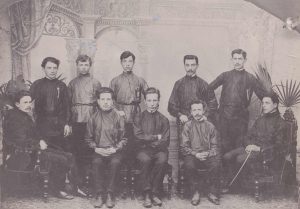Mary Crabapple in the New York Review of Books:
 During his elder years, my great-grandfather, the post-Impressionist artist Sam Rothbort, tried to paint back into existence the murdered world of his shtetl childhood. Amid the hundreds of watercolors that he called Memory Paintings, one stood out. A girl silhouetted against some cottages, her dress the same color as the crepuscular sky above. A moment before, she’d hurled a rock through one now-shattered cottage window. On the painting’s margin, her boyfriend offers more rocks.
During his elder years, my great-grandfather, the post-Impressionist artist Sam Rothbort, tried to paint back into existence the murdered world of his shtetl childhood. Amid the hundreds of watercolors that he called Memory Paintings, one stood out. A girl silhouetted against some cottages, her dress the same color as the crepuscular sky above. A moment before, she’d hurled a rock through one now-shattered cottage window. On the painting’s margin, her boyfriend offers more rocks.
“Itka the Bundist, Breaking Windows,” Sam captioned the work.
I may have been fifteen, seventeen, or twenty when I saw the watercolor, in my great aunt’s sunbaked living room or my mother’s apartment; I don’t recall exactly. What sticks with me is the Old World awkwardness of the heroine’s name. Itka. I turned the Yiddish syllables on my tongue. And Bundist. What was that?
This question became a thread that led me to the Bund, a revolutionary society of which my mother’s Grandpa Sam had been a member, whose story was interwoven with the agonies and triumphs of Jews in Eastern Europe, and whose name has all but been erased.
More here.
